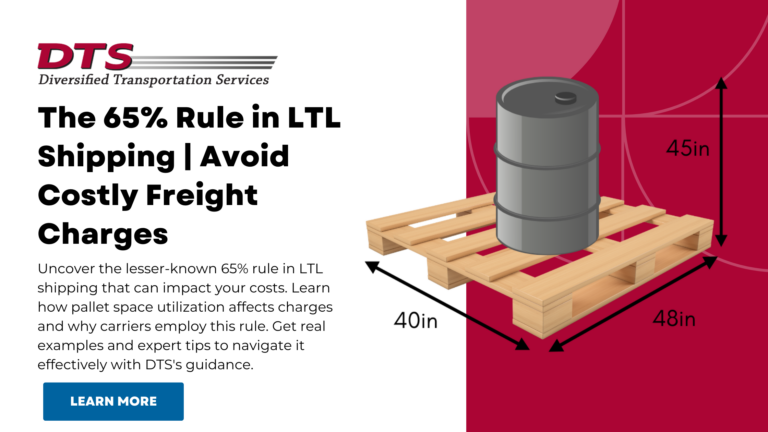
The 65% rule in LTL freight shipping is a little-known rule that can cause your freight charges to increase drastically due to your shipment being re-classed. This rule is listed differently by various carriers, such as FedEx and A Duie Pyle, who call it their Item 680 Rule while others call it the Packing or Packaging Rule. Click here to view how FedEx Freight describes the 65% rule in LTL Shipping.
The 65% rule in LTL shipping, is essentially when your shipment that is on a pallet, or shipping handling unit (SHU), takes up less than 65% of the capacity of that pallet or SHU. When this occurs, the Pounds Per Cubic Feet or PCF of the combined gross weight of the pallet and the goods being shipped will determine the actual costs for rating and NOT the actual class of the item. The outermost dimensions of the SHU will be calculated and then used to determine the Pounds Per Cubic Feet as a density factor. That density will then be used as the class to rate that particular shipment.
The rule is in place to guide shippers to properly package their shipments with the smallest pallets or SHU possible. This benefits everyone as when the less than truckload shipments take up less space on the trucks, the carriers can load more shipments on their trucks, and thus keep the costs down. Conversely, when a shipper uses an oversized pallet or SHU, the carriers may at their discretion choose to implement the Packing Rule and charge more money based on the density of the shipment versus its actual class.

In this example as noted in our picture above, the dims are 40x48x45 with a weight of 160 lbs. and an actual class of 100 based on the commodity.
The item 680 Rule was applied since the goods utilized less than 65% of the pallet space. The density was then calculated at 40x48x45 = 86,400 divided by 1728 (1 cubic foot), which yields 50 cubic feet on the actual shipment.
The carrier then took 160 lbs. divided by 50 cubic feet and came up with a density of 3.2 PCF. The class on an item at 3.2 PCF is class 250. The rate was then recalculated as a cl250 item and the rate went up by almost 100%.
There is a very simple solution for avoiding this rule. When shipping your goods, use the smallest pallet or SHU possible. It would have been more cost-effective for this client to cut down this pallet to a smaller size and then ship it out.
It is the shipper’s responsibility to know these rules or partner up with someone such as Diversified Transportation Services who can help avoid these charges with the knowledge that we bring to the table with 30+ years of experience. The carrier rules tariffs are in place equally for everyone and while some may not agree, the rule is a fair one. If you keep your shipment as tight as can be on a pallet or SHU, you will be in great shape. If you waste space on the carrier’s truck, they have a process in place to be compensated for that wasted space.
Therefore, a small amount of time having DTS help you analyze your packaging can help you save money that funnels to your bottom line. More details are on our Shipping and Receiving guide.
| If Density Is: | Apply Class For Rating Purposes: |
| Less than 1 pfc | 400 |
| 1 pcf but less than 2 pcf | 300 |
| 2 pcf but less than 4 pcf | 250 |
| 4 pcf but less than 6 pcf | 150 |
| 6 pcf but less than 8 pcf | 125 |
| 8 pcf but less than 10 pcf | 100 |
| 10 pcf but less than 12 pcf | 92.5 |
| 12 pcf but less than 15 pcf | 85 |
| 15 pcf but less than 22.5 pcf | 70 |
| 22.5 pcf but less than 30 pcf | 65 |
| 30 pcf but less than 35 pcf | 60 |
| 35 pcf but less than 50 pcf | 55 |
| 50 pcf or greater | 50 |
Whether you're a company looking to improve one facet of your supply chain, your entire supply chain, or simply looking for a transportation and logistics consultation, we can help.